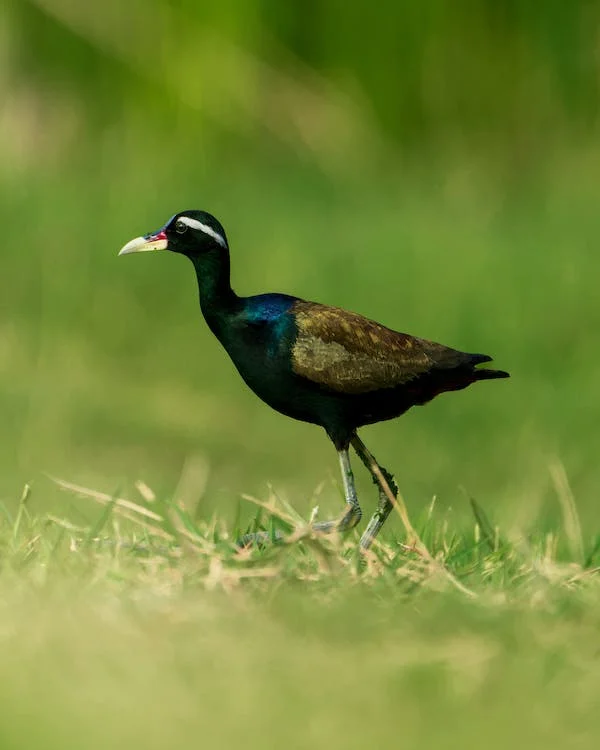The African Jacana, or also known as Actophilornis africanus, is a long-legged wader that belongs to the Jacanidae family. Birds that fall in the Jacanidae family include Lesser Jacana, Madagascan Jacana, Bronze-winged Jacana, Comb-crested Jacana, and Wattled Jacana. This bird species is famed for its ability to walk on floating vegetation, earning the nicknames Jesus Bird and Lily-Trotter. Sinking on the water is not a big problem for them because they are excellent swimmers.
It favors the freshwater wetlands that are found in the central and southern regions of the African continent.
Since their general population is on a continuous rise and there are no massive threats that can jeopardize their numbers, the International Union for Conservation of Nature (IUCN) Red List categorized this bird species as Least Concern.
Its seven levels of scientific classification are as follows:
Kingdom: Animalia
Phylum: Chordata
Class: Aves
Order: Charadriiformes
Family: Jacanidae
Genus: Actophilornis
Species: A. africanus
The physical characteristics of an African Jacana
This bird species is conspicuous—an African Jacana is an unmistakable bird that can be easily spotted. An adult African Jacana can grow to an average of 30 cm, with females being larger than males. A male African Jacana weighs 137 g, while a female African Jacana weighs around 260 g. Both male and female African Jacanas have short tails.
This bird has a rich chestnut or cinnamon plumage, except the chin, foreneck, and throat, which are white. However, its rump and secondaries are darker than the rest, while its primaries are black in color. Its upper wing has a glossy effect when sighted under the sun. It has black wingtips, eye stripes, and rear neck. Its upper breast is golden yellow. Contrary to the black and white colors of its head, the African Jacana’s eyes are dark brown.
The underparts are maroon-chestnut for adults, but in juveniles, they are pure white marked with a chestnut belly patch. Its bill is pale blue or grey-blue in color.
The bird is famous for its greyish-blue or olive-brown long legs and large toes that allow it to walk on floating vegetations.
The distribution and habitat of African Jacanas
The African Jacanas take refuge in freshwater wetlands such as lakes with floating vegetation like lily pads and other plants that emerge in marshes and swamps. It spends most of its time walking on large floating leaves.
These birds are widely distributed across sub-Saharan and central Africa. They steer clear from forested areas and arid zones, where wetlands are scarce.
The behavior of African Jacanas
These birds are not only conspicuous because of their striking colors, but also for their sharp, noisy calls. They utter calls like “krrrrek,” “kreep-kreep-kreep,” and a bark that sounds “kyowrrr.” When in flight, African Jacanas emit a loud screech.
Apart from being exceptional walkers on floating vegetation, they are excellent swimmers and divers. African Jacanas swim over water to hunt for food and underwater to avoid predators. Juveniles can also stay underwater, provided that their bill tips remain above the water surface.
When a predator threatens an African Jacana, it aggressively flaps its wings. The bird also cries a few loud calls if an intruder crosses its territory.
African Jacanas’ breeding habits and practices
The breeding and mating system of African Jacanas are fascinating. These competitive birds form large flocks that usually appear in a pandemonium state as they court and pursue each other relentlessly.
The courtship display involves circling each other with their heads lowered to brag their blue-grey frontal shield to one another. Then, the female African Jacana will crouch while the male will peck her body before mounting her.
The mating system is reversed—the males are responsible for securing a floating nest, while females are the ones that defend their territories against intruders.
African Jacanas are polyandrous birds, meaning a single female bird can breed with several male birds. As a matter of fact, a female bird can form a harem of four consorts. Each consort will have an opportunity to breed with a female African Jacana, who will then produce multiple clutches—up to eight or nine clutches each breeding season—with four eggs per clutch.
African Jacana’s diet
This bird’s diet consists of organisms that are usually abundant in wetlands such as insects, worms, snails, larvae, crustaceans, spiders, and mollusks. It can also prey on flying insects.
BOTSWANA BIRDS | SOUTH AFRICA BIRDS
NAMIBIA BIRDS | ZAMBIA BIRDS | ZIMBABWE BIRDS

